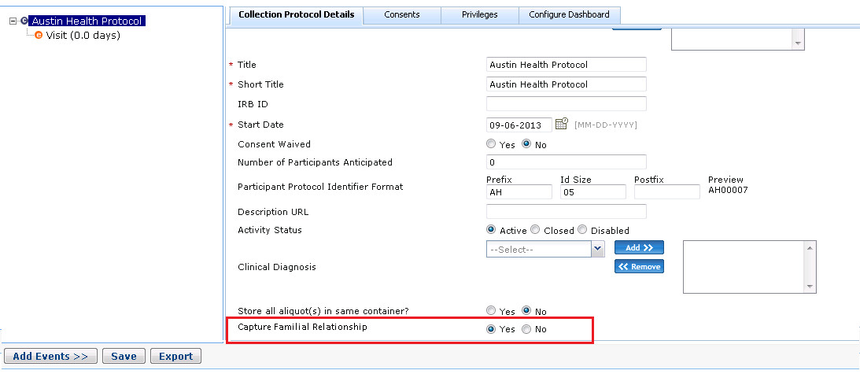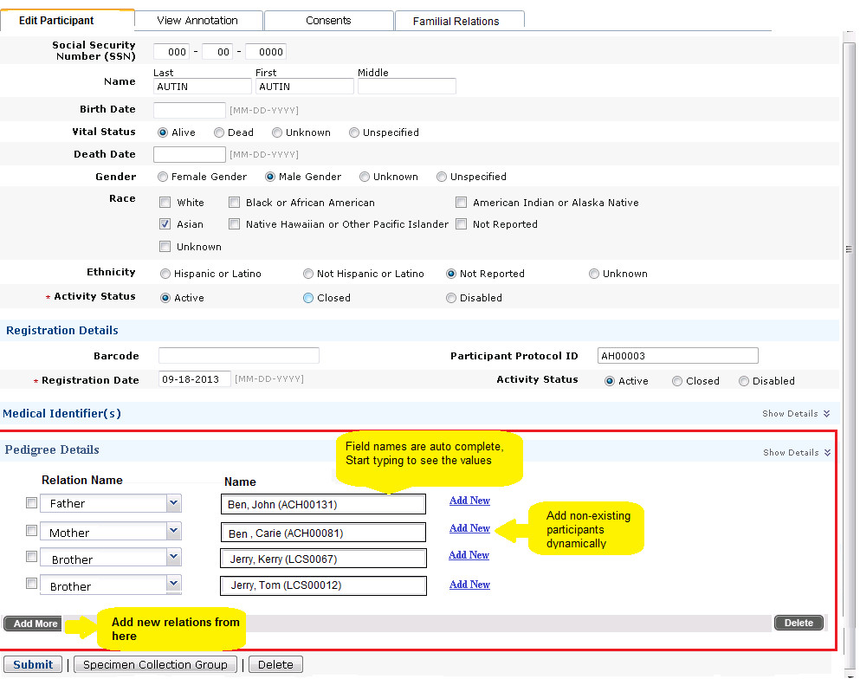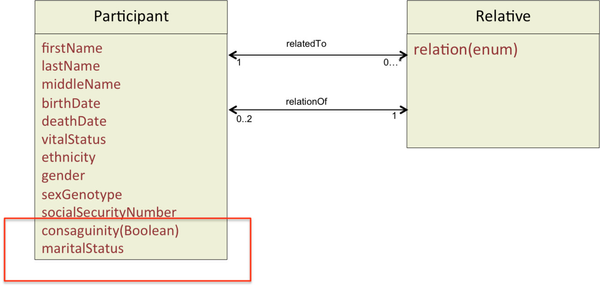...
...
...
...
...
...
...
...
...
...
...
...
...
...
...
...
...
...
...
...
...
...
...
...
...
...
...
...
...
...
...
...
...
...
...
...
...
...
...
...
...
...
...
...
...
...
...
...
...
...
...
...
...
...
| Table of Contents |
|---|
Introduction
Krishagni invites feedback from end user community on recording the participant's family relationship in caTissue PlusOpenSpecimen. In a particular or across protocol(s), there are participants registered who are related to each other. Below are some real use cases highlighting why capturing familial relation plays major role in many studies:
- Important risk factor for common chronic diseases such as cancer (like hereditary cancer syndromes) heart disease, and diabetes for which various centers conducts research to define, measure, and assess family history in populations and individuals
- Various biorepositories such as Breast and Colon cancer family registries conducts studies on the genetics and molecular epidemiology of breast and colon cancer
- A family history also can provide information about the risk of rarer conditions caused by mutations in a single gene, such as cystic fibrosis and sickle cell anemia.
- By noticing patterns of disorders among relatives, healthcare professionals can determine whether an individual, other family members, or future generations may be at an increased risk of developing a particular condition.
- Important in Pediatric genetics: Understanding genetic factors and genetic disorders is important in learning more about preventing birth defects, developmental disabilities, and other unique conditions among children.
High level requirements
- Administrator should able to turn on/off capturing familial relation feature at Collection Protocol level.
- User should be able to provide immediate family history information at participant level
- Should be able to view and download Pedigree tree.
- Support collecting consanguineous relation data
- Biospecimen searches based on familial relationships of participant.
Turn the feature on and off at CP level
Below are two different approaches to capture familial relation:
Approach-I
Fields Description:
| Attribute | Description |
|---|---|
| Relation Name | Drop down indicating family relation values ( Note: Evaluating Standards to refer family relations ) |
| Name of person | Text field box in which user can start typing the existing participant's First name, last name or PPID with whom user wants to record the relationship and system should show matching participants. User can select from the matching list. |
| Add New | New participants or members can be added if non-existing in caTissue OpenSpecimen ( caTissue OpenSpecimen Participant ID will get auto generated on creation) |
| Add More | To add multiple relations |
| Delete | Delete any existing relation(s) |
...
- Simple interface
- Capture multiple relations
- Non-existing members can also be added dynamically and included in the pedigree
Approach-II
Step by step approach to capture familial relation:
- Specify details about your immediate family members.
- In case of consanguineous relations :
- If user selects 'Yes' for it then spouse details text field which is auto complete field, should get displayed where user can specify the name/PPID of spouse. If non-existing then on click to 'Add New' new participant can be added dynamically for whom caTissue OpenSpecimen Participant ID will be system generated.
- If user selects 'No' then spouse should get auto added in the relation table which is displayed in the Next step.
- In case of consanguineous relations :
- On click to 'Next' button user should be able to view the relationship table.
...
- Step by step data entry
- Easily add multiple members of the family
UML model
Changes to existing class: Below new attributes will be added to the Participant class
...
Participant to Relative has two associations to indicate relation to and from a participant.
Value domain for relationship type
caTissue OpenSpecimen already uses relationship type drop down in Family History clinical annotation. We plan to use same permissible values list for relationship type which will be used to show different relations in the pedigree tree. See Relationship list for the whole set of values. This is registered on caDSR with public ID - 2690165.
Queries to be supported
caTissue Plus OpenSpecimen should allow biospecimen searches based on familial relationships of participant. Some sample queries that should be possible:
- Find specimens collected from all genetic siblings of particular participant. Show specimen and relationship of specimen’s donor to the participant.
- Find all specimens of a participant and specimens of participant’s relatives who are diagnosed with specific clinical diagnosis.
- Find all specimens of a participant whose maternal side is diagnosed with specific clinical diagnosis.


